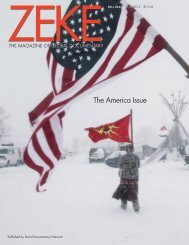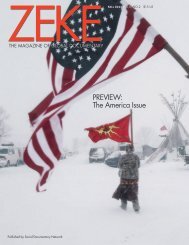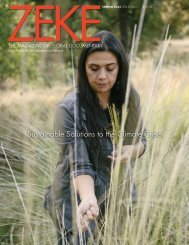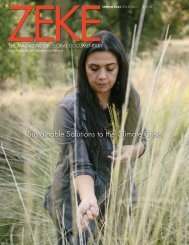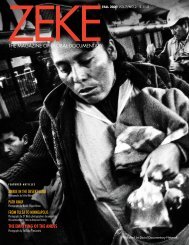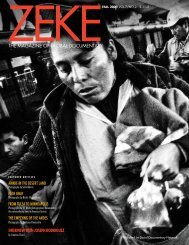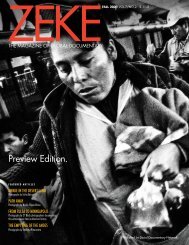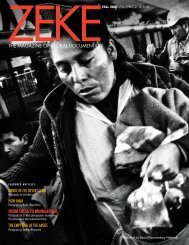ZEKE Magazine: Fall 2021, Photography and Social Change
By Emily Schiffer. Profiles of Ariana Faye Allensworth, Rosem Morton, and Deborah Espinosa
By Emily Schiffer. Profiles of Ariana Faye Allensworth, Rosem Morton, and Deborah Espinosa
Create successful ePaper yourself
Turn your PDF publications into a flip-book with our unique Google optimized e-Paper software.
<strong>ZEKE</strong>FALL <strong>2021</strong> VOL.7/NO.2 $15 US<br />
THE MAGAZINE OF GLOBAL DOCUMENTARY<br />
FEATURED ARTICLES<br />
AWAKE IN THE DESERT LAND<br />
Photographs by Sofia Aldinio<br />
PATH AWAY<br />
Photographs by Nicolò Filippo Rosso<br />
FROM TULSA TO MINNEAPOLIS<br />
Photographs by 27 Black photographers documenting<br />
this extraordinary time in American history<br />
THE EMPTYING OF THE ANDES<br />
Photographs by Emiliano Pinnizzotto<br />
PHOTOGRAPHY AND SOCIAL CHANGE<br />
By Emily Schiffer<br />
Published by <strong>Social</strong> Documentary <strong>ZEKE</strong> FALL Network <strong>2021</strong>/ 1
But before delving into how documentary<br />
photography is evolving, it is essential<br />
to first address the fight to change<br />
the internal practices <strong>and</strong> structure of the<br />
photo industry itself.<br />
One of the biggest problems in<br />
photography is the widespread percep-<br />
Years ago,<br />
tion among audiences that photographs<br />
during an artist talk at a journalism<br />
conference, I stated that I the extent to which a photographer’s<br />
don’t lie. Most people don’t underst<strong>and</strong><br />
don’t believe documentary photographs<br />
create social change. A consume. This knee-jerk assumption of<br />
personal biases impact the images we<br />
colleague stood up <strong>and</strong> interrupted my objectivity allows audiences to accept<br />
talk to disagree with me. Our impromptu an image as truth: forming hard-<strong>and</strong>fast<br />
opinions about events <strong>and</strong> cultures.<br />
debate--across an audience of photographers<br />
<strong>and</strong> journalism students--exemplifies Without critical assessment from the viewers,<br />
the photographer has tremendous<br />
an important dialog within our industry<br />
that is pushing the boundaries of how power over the value viewers assign to<br />
photography is created <strong>and</strong> used. Our the lives of the individuals pictured. Such<br />
power <strong>and</strong> representation have plagued<br />
the industry since the advent of photography<br />
as a medium. Recent momentum<br />
in acknowledging <strong>and</strong> changing these<br />
practices prompted the formation of<br />
collectives such as Women Photograph,<br />
MFON, Diversify Photo, Ingenious<br />
Photograph, <strong>and</strong> the Authority Collective,<br />
to name a few. Meaningful reflection<br />
about representation, connection, <strong>and</strong><br />
accountability are imperative starting<br />
points for anyone assigning, publishing,<br />
<strong>Photography</strong> &<br />
By Emily Schiffer<br />
disagreement hinged on different definitions<br />
of what “social change” looks like<br />
<strong>and</strong> means. I was asserting that images<br />
create awareness--which unreliably<br />
evokes empathy, shifts mindsets, <strong>and</strong><br />
inspires action. He was arguing that<br />
empathy is change. We were both right.<br />
Differentiating between raising awareness,<br />
fostering empathy, inspiring action,<br />
<strong>and</strong> changing conditions enables photographers<br />
to precisely define their goals<br />
<strong>and</strong> approaches for individual projects.<br />
A whole world opens up when<br />
we think of images as the start<br />
of a creative process—rather<br />
than the end goal.<br />
unchallenged authority creates a dangerous<br />
paradigm. Historically, photographers<br />
have been overwhelmingly white<br />
<strong>and</strong> male, which means they produced<br />
images of cultures, communities, <strong>and</strong><br />
people that were not familiar to them.<br />
On top of that, editors, curators, critics,<br />
<strong>and</strong> other industry gatekeepers have<br />
also historically been white <strong>and</strong> male,<br />
which further normalizes the white male<br />
gaze within the industry writ large, <strong>and</strong><br />
silencing other perspectives. This set-up<br />
causes glaring omissions in documentary<br />
narratives. Practically speaking,<br />
omissions amount to erasure, which is a<br />
quintessential tactic of colonialism <strong>and</strong><br />
oppression. Despite important changes<br />
in who is able to access the profession,<br />
<strong>and</strong> in how we think about photography,<br />
statistics show that the demographics of<br />
the industry remain largely unchanged.<br />
In 2020, 80% of A1 images in leading<br />
U.S. <strong>and</strong> European newspapers were<br />
created by male photographers. Issues of<br />
exhibiting, or creating photographs, let<br />
alone those attempting to create social<br />
change through photography.<br />
Sometimes, viewers need to physically<br />
see the errors in the dominant narrative<br />
in order to shift their mindset. Artists such<br />
as Alex<strong>and</strong>ra Bell, Wendy Red Star,<br />
<strong>and</strong> Tonika Lewis Johnson visualize the<br />
crisis of biased representation, enabling<br />
viewers to reflect on their perceptions<br />
of self <strong>and</strong> others. Bell redacts racist<br />
language in New York Times articles <strong>and</strong><br />
sometimes changes the imagery to reflect<br />
a more accurate depiction of the facts.<br />
She then wheatpastes the before <strong>and</strong><br />
after versions of the articles onto outdoor<br />
public walls: simultaneously holding the<br />
media accountable, <strong>and</strong> forcing viewers<br />
to confront their complacency when<br />
consuming media. Similarly, Red Star<br />
annotates photographs of Crow chiefs,<br />
originally taken by Charles Milton Bell in<br />
1880. Red Star uses red ink to provide<br />
historical <strong>and</strong> contextual information,<br />
2 / <strong>ZEKE</strong> FALL <strong>2021</strong>
Photo by Dawnee LeBeau. From Women of the<br />
Tetonwan, a portrait project celebrating the matriarchs<br />
of the Cheyenne River Sioux Tribe in South Dakota. <br />
Winona Kasto is one of our Lakota Lolihan' (cooks).<br />
It's a great honor to be able to offer food as nourishment<br />
<strong>and</strong> healing, especially at ceremonies <strong>and</strong><br />
community events.<br />
with individuals directly impacted by the<br />
issues their work addresses. Still, for others<br />
who photograph solo, like Dawnee<br />
LeBeau, an ongoing <strong>and</strong> deep community<br />
dialog dictates what is created <strong>and</strong><br />
shared. It is worth noting that all of the<br />
aforementioned photographers identify<br />
as part of the communities they document.<br />
Even people depicting their own<br />
cultures need accountability, <strong>and</strong> ceding<br />
power enriches photographic work.<br />
Listening, critical discourse, <strong>and</strong> reflection<br />
<strong>Social</strong> <strong>Change</strong><br />
on one’s own biases are even more vital<br />
for outsiders.<br />
thereby informing the viewer <strong>and</strong> commenting<br />
on non-Indigenous people’s lack<br />
of knowledge about Indigenous culture<br />
<strong>and</strong> history. Aware of how profoundly the<br />
media impacts our sense of self, Johnson<br />
created Englewood Rising, a communityled<br />
billboard campaign created <strong>and</strong><br />
paid for with funds raised by Englewood<br />
residents <strong>and</strong> activists to, “showcase<br />
Englewood’s everyday beauty <strong>and</strong><br />
counter its damage-centered narrative.”<br />
Created by the community, for the community,<br />
<strong>and</strong> in the community, this wildly<br />
popular project demonstrates how well<br />
someone from the community can portray<br />
other members within it.<br />
Discussions about representation<br />
<strong>and</strong> whether or not a solo perspective is<br />
always desirable have prompted photographers<br />
to share authorship <strong>and</strong> power<br />
in the image-making process. More<br />
horizontal approaches sometimes take<br />
the form of a collective voice, composed<br />
of many professional photographers, as<br />
is the case with Kamoinge (founded in<br />
1963), a collective working to “HONOR,<br />
document <strong>and</strong> preserve the history <strong>and</strong><br />
culture of the African Diaspora with<br />
integrity <strong>and</strong> insight for humanity through<br />
the lens of Black photographers.” Other<br />
artists, like Brenda Anne Kenneally, facilitate<br />
decade-long photography workshops<br />
With the politics of representation<br />
fresh on our minds, <strong>and</strong><br />
the raising of awareness as a<br />
baseline, we will look at examples<br />
of photographers leading<br />
our industry in a more responsible,<br />
<strong>and</strong> impactful direction.<br />
Whether making images collaboratively,<br />
using them to create conversations,<br />
creatively installing them in communities,<br />
or amplifying existing grassroots<br />
organizing, these projects engender<br />
active engagement from both the people<br />
impacted by these issues <strong>and</strong> the viewers<br />
seeing these projects--even when there is<br />
not an easy or clear solution.<br />
More →<br />
<strong>ZEKE</strong> FALL <strong>2021</strong>/ 3
<strong>Photography</strong> & <strong>Social</strong> <strong>Change</strong><br />
Projects<br />
That Inspire<br />
Introspection<br />
<strong>and</strong><br />
Challenge<br />
Oppressive<br />
Narratives<br />
Ariana Faye Allensworth<br />
Staying Power<br />
Ariana Faye Allensworth’s<br />
background in social work,<br />
urban studies, African<br />
American studies,<br />
<strong>and</strong> education enables her to<br />
deconstruct power imbalances<br />
in the photo industry.<br />
Her latest project Staying<br />
Power, implements her critique<br />
of how photography is<br />
taught, <strong>and</strong> how narratives are<br />
constructed <strong>and</strong> consumed.<br />
Staying Power is “a collaborative,<br />
multidisciplinary art <strong>and</strong> research project<br />
celebrating the people’s history of New<br />
York City public housing. The project<br />
offers counter-narratives to the stereotypes<br />
surrounding the New York City<br />
Housing Authority (NYCHA) through<br />
the lens of residents raised <strong>and</strong> living in<br />
NYCHA.”<br />
The project emerged out of<br />
Allensworth’s collaborative work at the<br />
Anti-Eviction Mapping Project (AEMP):<br />
visualizing injustice by mapping open<br />
data, collecting oral histories, producing<br />
storytelling projects in collaboration<br />
with tenants, facilitating mutual aid, <strong>and</strong><br />
researching real estate speculation <strong>and</strong><br />
corporate l<strong>and</strong>lordism.<br />
At AEMP, Allensworth worked closely<br />
with residents displaced by the demolition<br />
<strong>and</strong> downsizing of public housing.<br />
New York City, home to the largest public<br />
housing stock in the United States, is<br />
privatizing <strong>and</strong> defunding many public<br />
housing programs, a radical shift in<br />
how these programs are managed <strong>and</strong><br />
operated. “It’s an important moment to<br />
document public housing reform, <strong>and</strong><br />
to create room for people’s narratives,”<br />
explains Allensworth. The dominant<br />
‘failed public housing’ narrative stood<br />
in stark contrast to the breadth of lived<br />
experiences residents described.<br />
Housed online, Staying Power is a<br />
platform for publishing, discussing, <strong>and</strong><br />
presenting the NYCHA community’s<br />
histories. The content is also available<br />
through an open-ended series of booklets<br />
<strong>and</strong> postcards, distributed to subscribers<br />
through the postal service.<br />
The project explores how this community<br />
creates, cares for, <strong>and</strong><br />
builds their own archives.<br />
“Memory is a valuable historical<br />
resource,” explains<br />
Allensworth. “Staying<br />
Power explores how<br />
photography, ephemeral<br />
<strong>and</strong> personal collections<br />
of objects, <strong>and</strong> interviews<br />
with residents can offer<br />
alternative modes of knowledge<br />
that retell the public housing story. The<br />
project positions residents as archivists<br />
<strong>and</strong> storytellers.” Allensworth’s goal is to<br />
refute stereotypes that eclipse people’s<br />
lived experiences, <strong>and</strong> assert that all residents<br />
are worthy of inclusion in NYCHA<br />
history.<br />
To gather material, Allensworth<br />
facilitated photography workshops,<br />
conducted long-form oral histories, <strong>and</strong><br />
photographed ephemera. Teaching<br />
photography as a way of collaboratively<br />
building narratives poses a challenge: on<br />
the one h<strong>and</strong>, taking someone’s creativity<br />
seriously by helping them develop<br />
their craft is the ultimate form of respect.<br />
On the other h<strong>and</strong>, traditional photoeducation<br />
practices—which literally teach<br />
how to see—undermine the message that<br />
Image by Ariana Faye Allensworth. A poster created<br />
for Staying Power featuring an image of Michael Casiano,<br />
a resident of LaGuardia Houses on the Lower<br />
East Side of Manhattan.<br />
everyone’s perspective <strong>and</strong> story is valid.<br />
Allensworth didn’t want her aesthetic<br />
preferences to influence the work residents<br />
created. She structured her workshops<br />
using the “Photo Voice” model,<br />
inviting participants to create visual<br />
answers to questions about their public<br />
housing experience. Instead of focusing<br />
on aesthetics, the group discussed the<br />
messages the images delivered, <strong>and</strong> critiqued<br />
the artists’ visual communication.<br />
Similarly, Allensworth’s method of<br />
collecting oral histories positioned the<br />
narrator to author their own story: “I<br />
don’t show up with a predetermined set<br />
of questions, so they’re not reduced to<br />
whatever container I create for them.<br />
They decide what it is that they want to<br />
put on record.”<br />
Though created primarily for NYCHA<br />
residents, Staying Power is also an important<br />
resource for educators, activists, <strong>and</strong><br />
policy makers looking to counter erasure,<br />
claim space, <strong>and</strong> amplify residents’<br />
experiences without filtering them through<br />
a third party lens.<br />
4 / <strong>ZEKE</strong> FALL <strong>2021</strong>
Empathy <strong>and</strong><br />
Healing as<br />
<strong>Social</strong> <strong>Change</strong><br />
Rosem Morton<br />
Dear Survivor<br />
The p<strong>and</strong>emic of sexual assault<br />
is often presented through the<br />
lens of statistics: Every 68<br />
seconds an American<br />
is sexually assaulted. Every 9<br />
minutes, that victim is a child.<br />
Nine out of every ten victims<br />
of rape are female. 48% of<br />
victims were sleeping or at<br />
home. Research tends to focus<br />
on who is assaulted, by whom,<br />
where <strong>and</strong> when. What happens<br />
afterwards is understudied. What happens<br />
afterwards is profoundly important.<br />
We know that most survivors suffer in<br />
silence. And we know that most survivors<br />
continue to live. Rosem Morton created<br />
Dear Survivor to make resilience accessible<br />
instead of elusive. Designed to build<br />
community, Dear Survivor is a collaborative<br />
photo project, workbook, podcast,<br />
<strong>and</strong> resource platform exploring what it<br />
means to survive sexual trauma.<br />
Housed online, the project is a sort of<br />
one-stop resource for survivors <strong>and</strong> their<br />
allies. Morton explains, “Our website<br />
hosts a growing audio-visual collection<br />
empowering sexual trauma survivors<br />
through the expression of their own narratives.<br />
These stories highlight survivor<br />
experiences, illustrate the prevalence of<br />
sexual violence, <strong>and</strong> question how we<br />
can break this cycle.”<br />
Dear Survivor grew out of Morton’s<br />
creative exploration of her own trauma.<br />
“I tried to make sense of it by looking<br />
inward <strong>and</strong> photographing myself.” The<br />
process of making <strong>and</strong> sharing these<br />
images brought connection with other<br />
people, as well as new trauma.<br />
Not everyone knows how<br />
to be an ally, <strong>and</strong> Morton<br />
found that overall support<br />
for survivors is lacking.<br />
Still, her work resonated<br />
with viewers, <strong>and</strong> she<br />
was inundated with survivors<br />
confiding in her, often<br />
breaking their own silence.<br />
They, too, craved connection,<br />
community, healing, resources, <strong>and</strong> allies<br />
who knew how to support them. Morton<br />
decided to photograph other survivors,<br />
but quickly bumped up against the constraints<br />
of traditional documentary photography.<br />
She decided people needed to<br />
tell their own stories, <strong>and</strong> that she needed<br />
to embrace all forms of expression. Many<br />
of Morton’s participants found healing<br />
through creativity, so Morton set out to<br />
tap into their artistic processes, believing<br />
those expressions were as important to<br />
share as stories of resilience.<br />
Morton <strong>and</strong> her participants continue<br />
to aggregate resources <strong>and</strong> stories to<br />
cultivate the space they need. “I haven’t<br />
found anything out there that delineates<br />
possible questions, gathers resources,<br />
<strong>and</strong> showcases other people surviving.”<br />
The Survivor Workbook claims strength<br />
in vulnerability, <strong>and</strong> looks at what people<br />
do when pain blocks hope. It includes<br />
images of survivors’ art, guided questions<br />
to help people creatively explore their<br />
trauma journey, letters to survivors, <strong>and</strong><br />
multifaceted resources. The workbook<br />
Self-portrait by Rosem Morton. The Dear Survivor<br />
Project features the stories, art <strong>and</strong> images of<br />
survivors.<br />
is housed on the Dear Survivor website,<br />
alongside Morton’s photographs,<br />
survivor audio recordings, <strong>and</strong> a monthly<br />
podcast. Viewers can respond to stories<br />
or share their own via a submissions<br />
portal. Morton continues to exp<strong>and</strong> her<br />
audience. Her platform is used at mental<br />
health centers <strong>and</strong> universities in the U.S.<br />
<strong>and</strong> Philippines, <strong>and</strong> the project is currently<br />
engaging the public as a travelling<br />
outdoor exhibition.<br />
Created for people deep inside the<br />
healing process, Dear Survivor also<br />
invites people to shed oppressive cultural<br />
narratives. It refuses to accept the conditions<br />
of silence, isolation, <strong>and</strong> grief.<br />
Popular narratives use the term “victim”<br />
instead of “survivor,” <strong>and</strong> depict people<br />
forever crippled by their trauma. Morton<br />
refutes this trope by excluding it from<br />
her platform. “Although this trauma has<br />
changed us for the rest of our lives,”<br />
Morton explains, “we have found ways<br />
to move forward. It’s important for both<br />
survivors <strong>and</strong> the community to see the<br />
spectrum of our resilience. This is part of<br />
a more comprehensive narrative about<br />
survival.”<br />
More →<br />
<strong>ZEKE</strong> FALL <strong>2021</strong>/ 5
<strong>Photography</strong> & <strong>Social</strong> <strong>Change</strong><br />
“My debt: not only is it affecting me financially, mentally,<br />
emotionally, [but also] I want to live like normal<br />
people. It affects my mom, it affects my dad, <strong>and</strong> it<br />
affects my boys. My past is haunting me.” —Keshena,<br />
who, with interest, owes $50,000 in LFOs.<br />
Projects That<br />
Incite Action<br />
<strong>and</strong> <strong>Change</strong><br />
Conditions<br />
Deborah Espinosa<br />
Living With Conviction:<br />
Sentenced to Debt for Life in<br />
Washington State<br />
6 / <strong>ZEKE</strong> FALL <strong>2021</strong><br />
Lawyer <strong>and</strong> photographer<br />
Deborah Espinosa fuses her documentary<br />
<strong>and</strong> legal practices to<br />
expose how court fees <strong>and</strong> fines<br />
criminalize poverty, disproportionately<br />
punish low-income communities of color,<br />
<strong>and</strong> force formerly incarcerated people<br />
under the lifetime supervision of the<br />
criminal justice system. Espinosa<br />
explains, “Since the 1980s,<br />
people have been sentenced<br />
not only to prison, but also<br />
to a lifetime of debt in the<br />
form of court costs, fines,<br />
fees, <strong>and</strong> victim restitution—<br />
accruing interest at a rate<br />
of 12%. In Washington State,<br />
this debt is called Legal Financial<br />
Obligations or LFOs. The 12% interest<br />
begins to accrue on the day of sentencing,<br />
including while a person is in prison.<br />
At 12%, the original amount imposed<br />
doubles in five years. Many county courts<br />
send unpaid accounts to collection agencies,<br />
who charge an additional 19% to<br />
50% interest. In Washington State, 80%<br />
to 90% of criminal defendants cannot<br />
pay. Once released from prison, a person<br />
usually has 30 days to make the first<br />
monthly payment. If they miss too many<br />
payments, the court may summon them. If<br />
they fail to appear, they can be arrested.”<br />
Living With Conviction shares personal<br />
stories of the impacts of LFOs through<br />
photography, video, <strong>and</strong> audio recordings.<br />
“My goal is to elevate <strong>and</strong> amplify<br />
people’s stories, to create a platform for<br />
people with LFOs to speak on their own<br />
behalf.” Espinosa asks participants to<br />
describe how they want to be portrayed,<br />
choose the setting of their portrait, <strong>and</strong><br />
collaborate on the editing process. Audio<br />
<strong>and</strong> video recordings enable people to<br />
speak for themselves. Espinosa’s work<br />
enacts change from several angles:<br />
raising public awareness, connecting<br />
participants with legal resources,<br />
<strong>and</strong> advocating for legislative<br />
reform.<br />
LFOs exist in all states,<br />
yet are rarely included in<br />
mainstream conversations<br />
about incarceration or rehabilitation.<br />
Thus, at the base<br />
level, Living With Conviction<br />
accomplishes the important task<br />
of familiarizing the public with this<br />
pervasive issue. The project demonstrates<br />
how the financial pressure of LFOs impact<br />
entire families: reverberating across<br />
individuals’ mental health, self-care,<br />
resilience, rehabilitation, <strong>and</strong> recovery.<br />
Keshena, a project participant explains,<br />
“My debt: not only is it affecting me financially,<br />
mentally, emotionally, [but also] I<br />
want to live like normal people. It affects<br />
my mom, it affects my dad, <strong>and</strong> it affects<br />
my boys. My past is haunting me.”<br />
Espinosa raises awareness among<br />
new audiences by sharing Living With<br />
Conviction via public art installations,<br />
exhibitions, artist talks, publishing<br />
her work, <strong>and</strong> providing educational<br />
resources. She speaks about LFOs alongside<br />
project participants in schools, community<br />
centers, <strong>and</strong> at art institutions. “In<br />
the end, these are not my stories to tell,<br />
so it’s important for participants to speak<br />
directly with audiences. I also do this to<br />
break down the wall between communities<br />
with criminal histories <strong>and</strong> those without.<br />
We all want the same thing. To take<br />
care of our families. Connecting in person<br />
really helps get audiences invested.”<br />
The project does not stop at awareness.<br />
Individuals with LFOs are invited<br />
to connect with legal help. Living With<br />
Conviction partners with grassroots organizations<br />
run <strong>and</strong> facilitated by formerly<br />
incarcerated individuals such as, I Did the<br />
Time <strong>and</strong> the Civil Survival Project, which<br />
advocate for reform <strong>and</strong> provide legal<br />
assistance to people with LFOs. Living<br />
with Conviction supplements this work<br />
by training formerly incarcerated leaders<br />
to prepare court forms to request for a<br />
reduction of LFOs, <strong>and</strong> capture stories<br />
about court-imposed debt for legal advocacy<br />
<strong>and</strong> public education.<br />
Living With Conviction seeks to eliminate<br />
LFOs. After Espinosa <strong>and</strong> participants<br />
made this work available to the<br />
Washington State Legislature in the form<br />
of postcards <strong>and</strong> a magazine, lawmakers<br />
voted to amend state policy: creating the<br />
right to a waiver of accrued interest on all<br />
non-restitution LFOs, <strong>and</strong> stopping interest<br />
from accruing on all future non-restitution<br />
LFOs. Cited as an important influence on<br />
the legislature’s policy reform, Living With<br />
Conviction exemplifies the impact of fusing<br />
photography with activism.
Subscribe to <strong>ZEKE</strong><br />
$25.00* for two issues/year<br />
Includes print <strong>and</strong> digital<br />
*Additional costs for shipping outside the US.<br />
Subscribe to <strong>ZEKE</strong> magazine <strong>and</strong> get the best of<br />
global documentary photography delivered to your<br />
door, <strong>and</strong> to your digital device, twice a year. Each<br />
issue presents outst<strong>and</strong>ing photography from the<br />
<strong>Social</strong> Documentary Network on topics as diverse<br />
as the war in Syria, the European migration crisis,<br />
Black Lives Matter, the Bangladesh garment industry,<br />
<strong>and</strong> other issues of global concern.<br />
But <strong>ZEKE</strong> is more than a photography magazine.<br />
We collaborate with journalists who explore<br />
these issues in depth —not only because it is important<br />
to see the details, but also to know the political<br />
<strong>and</strong> cultural background of global issues that require<br />
our attention <strong>and</strong> action.<br />
Click here to find out how »<br />
Contents of <strong>Fall</strong> <strong>2021</strong> Issue<br />
Awake in the Desert L<strong>and</strong><br />
Photographs by Sofia Aldinio<br />
Path Away<br />
Photographs by Nicolò Filippo Rosso<br />
From Tulsa to Minneapolis: Photographing the<br />
Long Road to Justice<br />
Photographs by 27 Black photographers documenting this<br />
extraordinary time in American history<br />
The Emptying of the Andes<br />
Photographs by Emiliano Pinnizzotto<br />
Migration from the Northern Triangle<br />
by Daniela Cohen<br />
Interview with Joseph Rodriguez<br />
by Caterina Clerici<br />
<strong>Photography</strong> & <strong>Social</strong> <strong>Change</strong><br />
by Emily Schiffer<br />
Book Reviews<br />
Edited by Michelle Bogre<br />
<strong>ZEKE</strong> FALL <strong>2021</strong>/ 7









